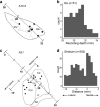Topographic distinction in long-term value signals between presumed dopamine neurons and presumed striatal projection neurons in behaving monkeys
- PMID: 32488042
- PMCID: PMC7265398
- DOI: 10.1038/s41598-020-65914-0
Topographic distinction in long-term value signals between presumed dopamine neurons and presumed striatal projection neurons in behaving monkeys
Abstract
Nigrostriatal dopamine (DA) projections are anatomically organized along the dorsolateral-ventromedial axis, conveying long-term value signals to the striatum for shaping actions toward multiple future rewards. The present study examines whether the topographic organization of long-term value signals are observed upon activity of presumed DA neurons and presumed striatal projection neurons (phasically active neurons, PANs), as predicted based on anatomical literature. Our results indicate that DA neurons in the dorsolateral midbrain encode long-term value signals on a short timescale, while ventromedial midbrain DA neurons encode such signals on a relatively longer timescale. Activity of the PANs in the dorsal striatum is more heterogeneous for encoding long-term values, although significant differences in long-term value signals were observed between the caudate nucleus and putamen. These findings suggest that topographic DA signals for long-term values are not simply transferred to striatal neurons, possibly due to the contribution of other projections to the striatum.
Conflict of interest statement
The authors declare no competing interests.
Figures








Similar articles
-
Reward and choice encoding in terminals of midbrain dopamine neurons depends on striatal target.Nat Neurosci. 2016 Jun;19(6):845-54. doi: 10.1038/nn.4287. Epub 2016 Apr 25. Nat Neurosci. 2016. PMID: 27110917 Free PMC article.
-
Striatal connections of the parietal association cortices in rhesus monkeys.J Comp Neurol. 1993 Jun 8;332(2):175-97. doi: 10.1002/cne.903320204. J Comp Neurol. 1993. PMID: 8331211
-
Representation of action-specific reward values in the striatum.Science. 2005 Nov 25;310(5752):1337-40. doi: 10.1126/science.1115270. Science. 2005. PMID: 16311337
-
Involvement of basal ganglia and orbitofrontal cortex in goal-directed behavior.Prog Brain Res. 2000;126:193-215. doi: 10.1016/S0079-6123(00)26015-9. Prog Brain Res. 2000. PMID: 11105648 Review.
-
Stimulus-response and response-outcome learning mechanisms in the striatum.Behav Brain Res. 2009 Apr 12;199(1):129-40. doi: 10.1016/j.bbr.2008.12.014. Epub 2008 Dec 14. Behav Brain Res. 2009. PMID: 19135093 Free PMC article. Review.
Cited by
-
Stable Neural Population Dynamics in the Regression Subspace for Continuous and Categorical Task Parameters in Monkeys.eNeuro. 2023 Jul 10;10(7):ENEURO.0016-23.2023. doi: 10.1523/ENEURO.0016-23.2023. Print 2023 Jul. eNeuro. 2023. PMID: 37385727 Free PMC article.
-
Dopamine transients follow a striatal gradient of reward time horizons.Nat Neurosci. 2024 Apr;27(4):737-746. doi: 10.1038/s41593-023-01566-3. Epub 2024 Feb 6. Nat Neurosci. 2024. PMID: 38321294 Free PMC article.
-
Dynamic prospect theory: Two core decision theories coexist in the gambling behavior of monkeys and humans.Sci Adv. 2023 May 19;9(20):eade7972. doi: 10.1126/sciadv.ade7972. Epub 2023 May 19. Sci Adv. 2023. PMID: 37205752 Free PMC article.
-
Multi-timescale reinforcement learning in the brain.bioRxiv [Preprint]. 2023 Nov 14:2023.11.12.566754. doi: 10.1101/2023.11.12.566754. bioRxiv. 2023. PMID: 38014166 Free PMC article. Preprint.
References
-
- Björklund A, Dunnett SB. Dopamine neuron systems in the brain: an update. Trends Neurosci. 2007;30:194–202. - PubMed
Publication types
MeSH terms
LinkOut - more resources
Full Text Sources

